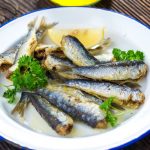Such a simple supper or light lunch idea, and super easy for kids to make ... and learn to love fish!
Sardines, even canned ones, are packed with heart-healthy omega-3 fatty acids, and they’re a natural source of vitamin D. They are also a fantastic source of calcium due to the soft, edible bones.
Skills Check
Follow a recipe; follow food safety & hygiene rules; tidy away; use measuring spoons and cups; use weighing scales; use a tin opener safely; beat ingredients together; mash; use a citrus squeezer.
Equipment
Tin Opener, Measuring Spoons, Fork, Spoon, Bowl, Citrus Squeezer, Grill.
Allergens (Please note the allergens listed above are indicative only. Allergens vary depending on brand; check the labels on the products you use)
Gluten | Mustard | Eggs | Milk | Fish | Soya
Ingredients (serves 4):
- 1 can of sardines in tomato sauce
- 1 tbsp reduced fat mayonnaise
- Juice of 1/2 lemon
- 4 slices of crusty wholemeal bread
Method
- Open the tin of sardines and place in a mixing bowl; mash lightly with a fork.
- Spoon the mayonnaise into the bowl with the sardines.
- Squeeze the juice of 1/2 a lemon into the same bowl.
- Mix all of the ingredients thoroughly together.
- Lightly toast one side of each slice of bread and then divide the sardine mixture evenly between the slices. Spread the mixture on the non-toasted side and then place under the grill for a couple of minutes to warm.
So thinking about simple sardines in toast ...

Bread is a good source of complex carbohydrates which gives us energy. It is also a good source of fibre and B vitamins. In general, wholemeal bread tends to be more nutritious than white, and it also contains more fibre.
Nutritional Information
| Energy | 807kJ/192kcal | 10% | |
| Med | Fat | 6.5g | 9% |
| Med | Saturates | 1.5g | 7% |
| Low | Sugars | 1.8g | 2% |
| Med | Salt | 0.9g | 15% |
per 90g serving
% of an adult's reference intake
Typical values per 100g: Energy 896kJ / 213kcal
Notes
A traffic light system is used on nutrition labels to make it easier to see which foods and drinks are lower in calories, fat, sugar and salt. Try and choose more ‘greens’ and ‘ambers’ and fewer ‘reds’, and stick to smaller portions of ‘reds’.
Just because a recipe or a food has a red traffic light doesn’t mean you shouldn’t eat it. Understanding why a food or recipe might have a red light can be helpful. For example oily fish is high in total fat and so any recipe containing oily fish is likely to be ‘red’ for fat. But it is recommended that we eat oily fish at least once a week because the type of fat it contains is beneficial for our health.
% Reference Intakes are also shown. Reference Intakes are guidelines about the approximate amount of particular nutrients and energy required for a healthy diet (based on an average-sized woman doing an average amount of physical activity). Most children will require less than these Reference Intakes. The contribution of one serving of a food or drink to the Reference Intake for each nutrient is expressed as a percentage.




